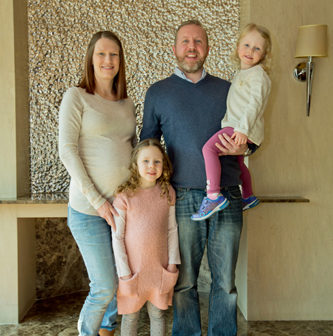Brits Catherine Lambert and David Lambert moved to Beijing in April 2012 with their daughter Zara. Now 5, Zara has a little sister called Sienna (age 3) and both attend the British International School of Beijing. Catherine is a stay-at-home mom and David is the finance and IT director for an American agricultural company.
How important is the issue of air pollution to you and your family and how has your understanding of it changed over the years?
When we first moved to Beijing, we knew very little about the city’s pollution; it wasn’t something that was widely talked about abroad. When we visited prior to moving here, we experienced a mediocre day but we didn’t fully appreciate how bad it could get.
Our youngest daughter was born in Beijing in early 2013 at the same time [the city]was experiencing off-the-scale air pollution. These two events led me to do more research into the effects of air pollution; I read what data there was available online and attended a couple of information talks. With the availability of apps nowadays, it is much easier to keep on top of the situation. You also learn to recognize how good or bad the pollution is just by looking out the window at specific landmarks!
Do you talk to your children about air pollution?
I have talked to Zara and Sienna about air pollution and sometimes they will ask questions about it. They know that when the AQI reading is over 150, it’s a “mask day” and they wear them without a problem. I have explained to them that when it’s a “bad air day” it can give them a cough or a sore throat.
Cat, you’re currently pregnant. How has this influenced your outlook and response to bad air days?
I always focused on Zara and Sienna and made sure they wore their masks without always bothering to wear my own; I guess I thought it wasn’t as important, my lungs being fully developed [and all]. But now, not knowing exactly how air pollution could affect my baby, I reduce the time I spend outside if the air is bad and make the most of good air days to run errands.
How do you keep up-to-date on air pollution in Beijing?
I track the AQI through two air quality apps that use different parameters, and I read the news and research studies when something new comes out in the media. I also check the wind on a website called windfinder.com, which gives a three-hourly forecast of wind conditions for the next 10 days.
What measures does your family take to minimize the effects of air pollution?
We have air purifiers in every room – more than one in some rooms – and I bought a Laser Egg monitor last autumn. I keep the purifiers on at all times and make sure they are turned up to max when the AQI reaches 150. We also make sure our windows are sealed to reduce airflow from outside. We wear masks outside when the AQI is over 150. When the AQI is over 200, we try to stay in, only going out for short periods of time, going to and from school, or to keep specific appointments. By keeping the air in our apartment as good as possible, I rest assured that for the majority of our day-to-day life we are breathing great air. After all, my children spend a lot of time asleep at night!
How did you settle on the products you currently use?
I decided to try Vogmask after reading data on various masks and the practical reduction in air pollution each provides, but also importantly for the comfort factor. Vogmasks fit well, the sizing is good, and we can wear them for a good length of time. I use an added piece of elastic on the Vogmask that I tie onto each ear hook, which then fits around the back of my children’s heads – a bit like a pair of swimming goggles – as I find this keeps a tighter seal around their faces and helps stop the mask from coming off. We use two different brands [of air purifiers], but IQAir is the one we are happiest with. I researched the effectiveness and air turnover rate for different air purifiers, as well as independent reviews online.
What measures does your child’s school use to deal with air pollution?
At BSB Sanlitun, there are detailed policies in place to reduce children’s exposure. For example, children don’t play outside when the AQI reaches 200 and are encouraged to wear their masks over AQI 150, and the school has good policies in place to ensure that doors stay closed and air purifiers are turned up to maximum. There are air purifiers around the school and in classrooms, and “air curtains” by the external doors.
I’m happy with the school’s level of preparedness, and more importantly of their awareness of the situation and commitment to constantly improve. BSB has recently started publishing a weekly update of PM2.5 readings around different parts of the school.
This article originally appeared on page 48 of the beijingkids March 2016 issue. Click here to read the issue for free on Issuu.com. To find out how you can get your own copy, email distribution@truerun.com




